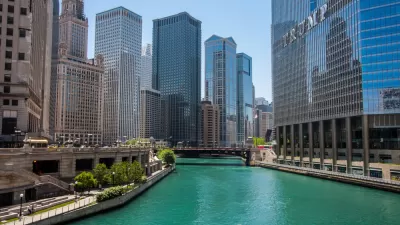The most conspicuous example of Chicago's recent spat of troubling signage is a 2,891-square-foot sign 200 feet above street level on the Trump International Hotel and Tower in Chicago.

"It's a sign-plastered world out there, and nothing, not even Wrigley Field, is safe or sacred….Signs are so pervasive that we've become numb to them and their impact on our psyches and surroundings," writes Chicago Tribune architecture critic Blair Kamin.
Kamin calls the sign an "on-steroids version of Trump's ubiquitous logo and its bold serif typeface," and most troubling is the impact the sign has on the street: "The big letters loom over the beaux arts Michigan Avenue Bridge and the great skyscrapers, from the wedding cake of the Wrigley Building to the corncobs of Marina City, that are visible from the span. To be sure, the nearby Tribune Tower has a prominently displayed sign, but it's on an attached structure, not the neo-Gothic skyscraper itself. The Trump sign, by comparison, is a poke in the eye."
Kamin's larger point is that Trump sign is only the most recent example of carte blanche granted to signage in the city, which lacks "sophisticated design guidelines as well as the teeth to enforce them."
Other writers have also produced strong critiques, including Neil Steinberg of the Chicago Sun-Times, who cites the sign as a symbol of the "emptiness of vanity." Writes Steinberg: "Who does this sign benefit? Out-of-towners who pass by and wonder which building this is? The hotel and condo owners ballyhooing themselves? As bad as being Donald Trump undoubtedly is, being caught basking in his glow is even worse."
FULL STORY: Donald Trump: Giant sign on his Chicago tower is like Hollywood sign

Maui's Vacation Rental Debate Turns Ugly
Verbal attacks, misinformation campaigns and fistfights plague a high-stakes debate to convert thousands of vacation rentals into long-term housing.

Planetizen Federal Action Tracker
A weekly monitor of how Trump’s orders and actions are impacting planners and planning in America.

San Francisco Suspends Traffic Calming Amidst Record Deaths
Citing “a challenging fiscal landscape,” the city will cease the program on the heels of 42 traffic deaths, including 24 pedestrians.

Defunct Pittsburgh Power Plant to Become Residential Tower
A decommissioned steam heat plant will be redeveloped into almost 100 affordable housing units.

Trump Prompts Restructuring of Transportation Research Board in “Unprecedented Overreach”
The TRB has eliminated more than half of its committees including those focused on climate, equity, and cities.

Amtrak Rolls Out New Orleans to Alabama “Mardi Gras” Train
The new service will operate morning and evening departures between Mobile and New Orleans.
Urban Design for Planners 1: Software Tools
This six-course series explores essential urban design concepts using open source software and equips planners with the tools they need to participate fully in the urban design process.
Planning for Universal Design
Learn the tools for implementing Universal Design in planning regulations.
Heyer Gruel & Associates PA
JM Goldson LLC
Custer County Colorado
City of Camden Redevelopment Agency
City of Astoria
Transportation Research & Education Center (TREC) at Portland State University
Jefferson Parish Government
Camden Redevelopment Agency
City of Claremont



























